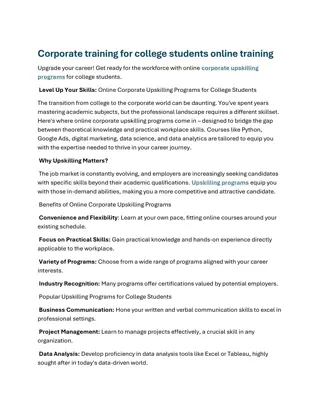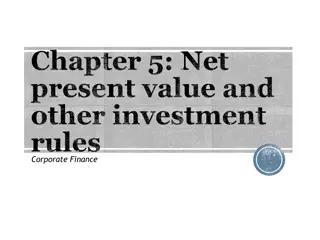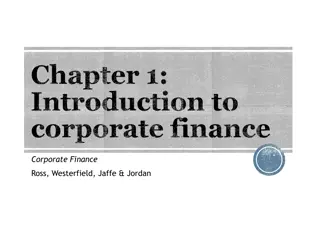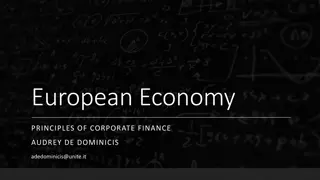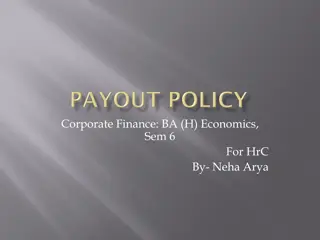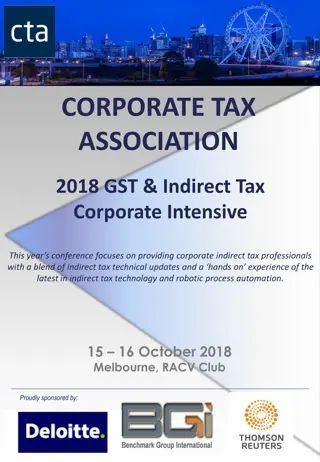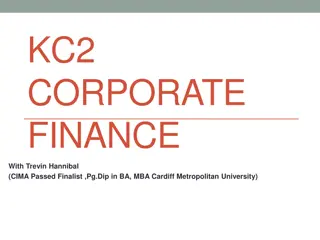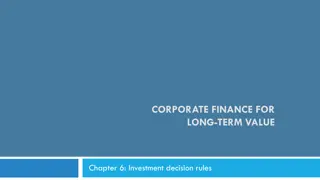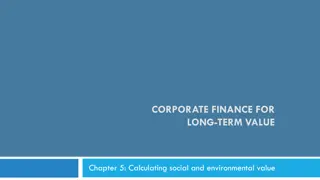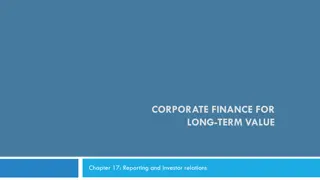Integrated Value Creation in Corporate Finance
Explore the concept of integrated value creation in corporate finance, emphasizing the importance of managing for long-term value while incorporating social and environmental goals. Learn about responsible management practices that focus on creating net present value (NPV) through a balance of financial and societal impacts, and how companies can align financial value (FV), shareholder value (SV), and environmental value (EV) for sustainable success.
Download Presentation

Please find below an Image/Link to download the presentation.
The content on the website is provided AS IS for your information and personal use only. It may not be sold, licensed, or shared on other websites without obtaining consent from the author. Download presentation by click this link. If you encounter any issues during the download, it is possible that the publisher has removed the file from their server.
E N D
Presentation Transcript
CORPORATE FINANCE FOR LONG-TERM VALUE Chapter 2: Integrated Value Creation
Part 1: Why corporate finance for long-term value? Chapter 2: Integrated Value Creation
The BIG Picture 3 Many companies are currently value destructive on SV and EV Solution Corporate strategy is starting point for value creation Challenge 1: incorporate social and environmental goals in strategy Challenge 2: move from static to dynamic perspective Envisage transition pathways towards value creation on SV and EV A company s transition preparedness is key determinant of its long-term value
What is value creation? 4 In financial terms, value creation is defined as an increase in the net present value (NPV) of a company s projects FV is often generated at the expense of SV and EV as resources are depleted without sufficient investments in maintaining them Responsible companies manage for integrated value creation (profit and impact) rather than merely shareholder value (profit)
The alignment of FV, SV and EV 5 External impacts (also called externalities) are costs or benefits that are created by organisations or persons but whose costs are borne by society as a whole A way to improve the alignment between FV, SV and EV is to ensure that companies charge true prices or integrated prices (prices that include all hidden costs) Source: True Price (2020)
The alignment of FV, SV and EV 6 Currently, many companies are value destructive on SV or EV For society and the economy to operate within social and planetary boundaries, we need companies on aggregate to stop being value destructive on SV and EV
Why is it in companies interest to manage for integrated value? 7 If company management neglects SV or EV, that will hurt long-term FV as well Ethical case - license to operate -> corporate responsibility US survey shows that 63% of US citizens (including 71% of millennials) expect companies to contribute to social and environmental challenges (Cone Communications, 2017) Companies that create FV at the expense of SV or EV are likely to lose their license to operate at some stage (Kurznack et al, 2021) Business case long-term value creation Companies that create value on SV and EV are more likely to be value creative on FV in the long run as well As external impacts are being internalised, they affect FV
Internalisation 9 Rationally, some companies are better off if they can continue to externalise their large costs on SV and EV, if: Companies are not interested in double materiality (see slide below) 1. There is no threat of internalisation 2. We distinguish four driving forces behind the internalisation of SV and EV into FV: License to operate 1. Regulation and taxation 2. Technological advancement 3. Customer preferences 4.
Forced internalisation 10 When internalisation happens it s not necessarily the worst polluters that are hit hardest The impact depends on the company s preparedness and the relative size of its external impacts versus alternatives The relationship between integrated prices and integrated profits is not linear. An integrated price can lead to higher costs for a producer and still increase profits
Forced internalisation 11 Cost price (in $) Cost price with CO2 tax (in $) 2500 2500 2000 2000 1500 1500 1000 1000 500 500 0 0 MiningCo1MiningCo2MiningCo3MiningCo4MiningCo5MiningCo6 MiningCo1MiningCo2MiningCo3MiningCo4MiningCo5MiningCo6 Change in profit margins (in $) Conclusion: mining company 5 was least prepared and 3 most prepared 250 200 150 100 50 0 MiningCo1MiningCo2MiningCo3MiningCo4MiningCo5MiningCo6 -50 -100 -150
Key players in internalisation 12 Several players are relevant for internalisation their roles are largely complementary Government: prime mover setting regulation and taxation; also active role (e.g. initial investor) to accelerate sustainability transitions 1. Investors: can incorporate ESG in lending + invest decisions; engagement with companies to speed up transitions to sustainable business models and/or exit (see Chapter 3) 2. Companies: can incorporate costs of externalities into business practices -> managing for integrated value (this book) 3. Consumers: may buy sustainable products and services; sharing / peer-to-peer economy, where consumers mutualise access to products instead of ownership 4. Civil society: non-governmental organisations (NGOs) can raise awareness of S + E issues through public voice in the media -> to stimulate other players to act (see Chapter 14) 5.
Double materiality 13 The concept of double materiality means that one is mindful of the company s relation with society and Dependencies (Inward) nature in both directions: Business & financial value Company s dependencies on society and nature (inward) 1. Society & nature Internalisation rate Company s impact on society and nature (outward) 2. Finance typically cares about the first (ESG risk) and ignores the second (impact) Impacts (Outward) Solution: steering on integrated value (profit and impact)
Value Creation Matrix 14 S + E value destroying S + E value creating F value creating Quadrant 1 Overexploitation Quadrant 2 Win-win F value destroying Quadrant 3 Collapse Quadrant 4 Charity
Value Creation Matrix -> transition 15 S + E value destroying S + E value creating F value creating Quadrant 1 Overexploitation Quadrant 2 Win-win Successful transition Unsuccessful transition F value destroying Quadrant 3 Collapse Quadrant 4 Charity
Measuring historical value creation 16 Measuring SV or EV takes a three-step process: Determine material S and E issues 1. Quantify the S and E issues in their own units (Q) 2. Put a monetary value on those S and E units through shadow prices (P) 3. Source: Adapted from True Price (2014)
Estimating future value creation 17 Future value destruction can be estimated by extrapolating its units and shadow price 2022 2023 2030 Expected units (1) Shadow price (2) Expected value destruction (3)=(1)x(2) It is not only important to understand whether companies are value creative or value destructive on SV, EV, and FV But it is also important to understand how to create or destroy such value and how they perform versus peers
Value management 18 In the integrated view: Value management (FV only)
Intangible assets in financial reporting 19 Significant parts of FV do not appear on corporate balance sheets. The financial value of companies has shifted from tangible assets (land, buildings & machinery, and financial assets) to intangibles (human capital, intellectual property (IP), processes, data and innovation) Tangible assets (on-balance) Intangible assets (on-balance) Intangible resources (off-balance) Cash Property, plant & equipment Innovation power Human capital Non-capitalised brands Etc. Brands Licenses Goodwill Etc.
SV and EV in reporting 20 SV and EV tend to be almost completely off-balance sheet This is only partly mitigated by sustainability reporting Companies need to be held more accountable and take more accountability to perform integrated reporting This allows investors and other stakeholders to make reasonable estimates of companies value creation profiles
Corporate Value Creation Profile 21 15 10 5 0 FV SV EV -5 -10 -15 -20
Where does value come from? 22 Since integrated value means that FV, SV and EV need to be positive, this raises the question of what to prioritise and how to balance these types of value Choice of parameters a and b by company board; FV has parameter 1 ?? = ?? + ? ?? + ? ?? How do companies know what to focus on? Focus and balancing should depend on the company s: Purpose 1. Area(s) of value destruction 2.
Purpose 23 A company finds focus in its mission or purpose (Mayer, 2018) Why and for what does the company exist? What societal need does it serve? What value does it provide for its customers? How does it do that in the best way? What type of value should it focus on, without losing sight of the other types?
Strategy 24 Based on its mission, focus, and competitive landscape, a company can build its strategy A strategy can be described as the plan chosen to achieve a desired future state Hambrick and Fredrickson (2001) claim a strategy needs to have five parts: Arenas: in which markets is the company going to be active? 1. Vehicles: how is it going to get there? 2. Differentiators: how can the company win in the marketplace? 3. Staging: what will be the speed and sequence of moves? 4. Economic logic: how can returns be obtained? 5.
Business model 25 Johnson et al. (2008) argue that a successful business model has three components: Customer value proposition: helps customers perform a specific job Profit formula: generates value for the company Key resources and processes: the people, technology, products, facilities, equipment and brand required to deliver the value proposition To change a company s value creation profile on FV, SV and EV, this involves strategic changes to the components of its business model
Stakeholder impact maps 26 Stakeholder impact maps can be used to investigate what a company s most material issues are It outlines the company s main stakeholders, their main goals, and the way the company helps them (positive impact) or hurts them (negative impact) Stakeholder group 1 Stakeholder group 2 Stakeholder group 3 Stakeholder group 4 Goals How the company helps those goals How the company hurts those goals
Stakeholder impact map for a pharmaceutical company 27 Doctors & hospitals Patients Governments Shareholders Employees Insurers Doctors get sweeteners; hospitals minimise costs Survival, affordability & accessibility Reduce healthcare costs Good work-life balance and pay Maximise financial return Short term goals Minimise costs Frictions Personal development & financial security Better health outcomes at decent price Better health outcomes at decent price Better health outcomes at decent price Better health outcomes at decent price Maximise financial return Long term goals High prices & high growth, new drugs drive share price Good treatment outcomes Fewer other costly treatments Treatment & possibly cured Population health Remuneration & job fulfilment Positive impact Potential company reputation Fees (prices) paid High R&D costs, high risk Negative impact High cost High prices High prices
Stakeholder impact map for a social media company 28 Users Advertisers Shareholders Employees Governments Control of information, data security; battle distorted news Good work-life balance and pay Connect & share Get more customers Maximise financial return Short term goals Better understanding of customer needs Personal development & financial security Protect the state and the people Maximise financial return Long term goals A good life Frictions Connect people, widen their opportunity to express themselves Reach users in a targeted way, save costs elsewhere High growth drives share price Remuneration & job fulfilment Positive impact Reach people Might affect public opinion in a way that undermines government Unease at value (valuation) Potential company reputation Privacy, addiction Negative impact Frictions
Transition 29 The move from a negative social and/or negative value to a positive value profile across all three value dimensions is often part of a wider transition in the economy. Transition is about transformational change rather than incremental change The x-curve of transition dynamics Source: Adapted from Loorbach, Frantzeskaki and Avelino (2017).
Transition 30 The SDG agenda sets the stage for the transition to a sustainable and inclusive economy, with several identified transitions: Climate Energy transition: Moving from the use of fossil fuels to renewable energy Raw Materials Circular Economy: Redesign and recycle products leading to less use of raw materials and fewer carbon emissions Biodiversity Healthy Food and Regenerative Agri- and Aquaculture: Trend towards healthy food production with respect for land and water Labour practices Social Transition: Trend towards decent labour practices across the value chain of production
Transition and value 31 Transitions can have major implications for company value A company that adapts in a timely manner to the new world can realise its integrated value potential In contrast, a company that follows a business-as-usual path and fails to adapt can lose its value and go bankrupt
Transition and value 32 The formula to estimate expected transition losses ETLijfor company i in sector j is: ?????= ????? ??? ???? = ?? ?? ??? (1 ??) ????? = exposure to transition = ?? ??, where ?? = level of transition in sector j, and ?? = value of company i ??? = probability of transition in sector j ???? = loss given transition = 1 ??, where ?? = company i s adaptability to transition
Example of car market 33 A car market where bcar= 1
Can Volkswagen catch up? 34 And where aVW= 0.4
Potential VW losses? 35 ????,?= ?? ?? ??? (1 ??) ????,?= 1 ??? 1 1 0.4 = 0.6 ??? 60% of VW s value Conclusion: ??- adaptability or transition preparedness is a key factor for company valuation Need fundamental analysis to assess parameters ??and ??
Transition pathways 36 When a company is value destructive on any type of value (FV, SV, or EV) it needs to find a credible transition pathway in line with social and planetary boundaries towards positive value Value creation profile 2020 Value creation profile 2040 15 15 10 10 5 5 0 FV SV EV 0 FV SV EV -5 -5 -10 -10 -15 -15 -20
Steering your company on integrated value 37 Goals: Companies should steer according to FV, SV and EV in an integrated way. This is the process of optimising the company s integrated value. Integrated value Constraints: Companies need to survive the transitions in the market and also need to operate within social and planetary boundaries Environmental value Financial value Social value Goals With a future-proof business model, companies can attract funding and avoid bankruptcy Accounting for transitions Social Planetary boundaries Constraints foundations
Conclusions 38 Creating value on FV, SV and EV requires a clear view of all types of value creation Internalisation shifts the burdens of externalities back from society to the companies If companies FV depends on the exploitation of an external impact, that FV will be affected when internalisation occurs Stakeholders can use the Value Creation Matrix to identify value creation on SV and EV Based on companies purpose and area(s) of value destruction, companies can adjust their strategy and business model In the case of serious value destruction, companies should be able to outline a credible transition pathway





